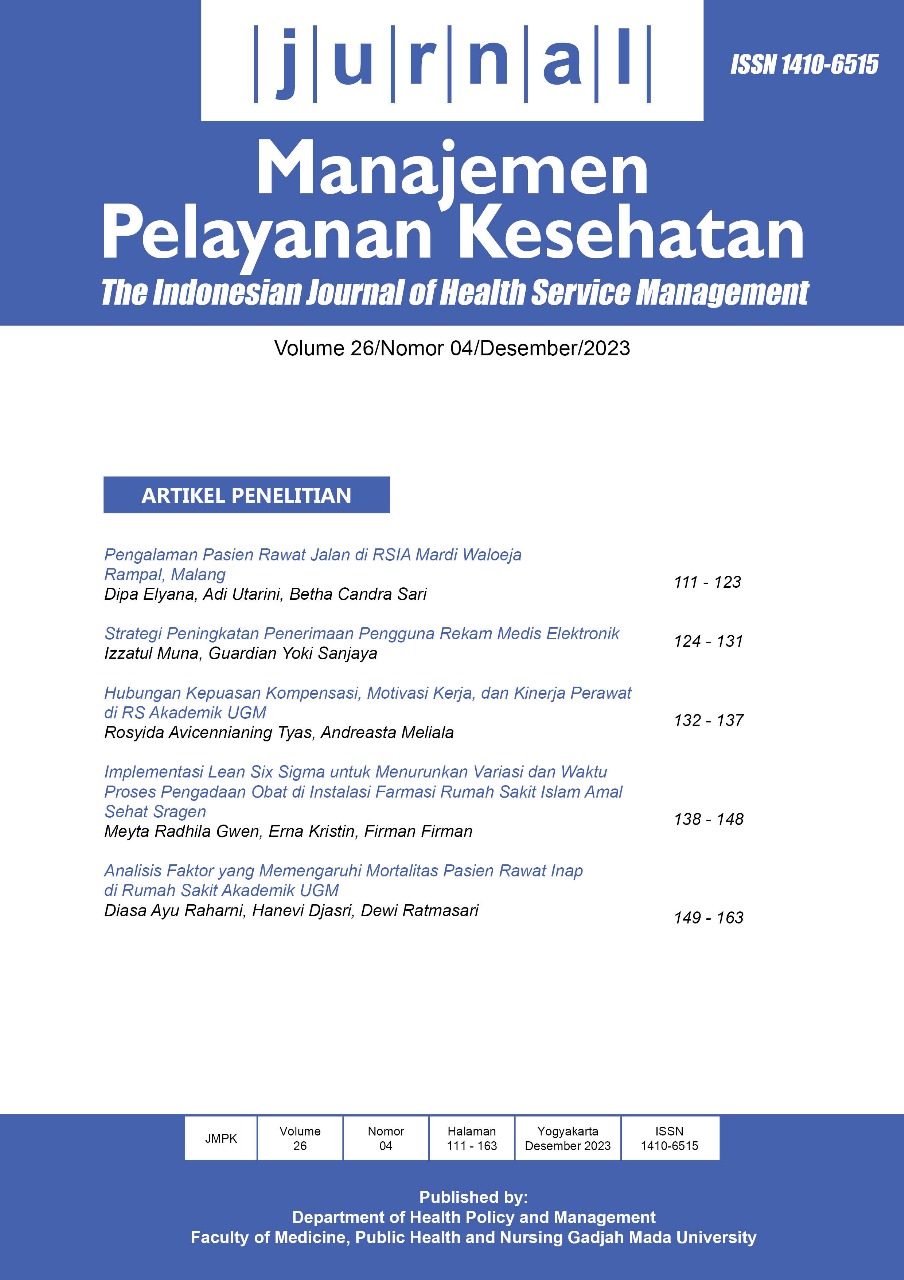IMPLEMENTASI LEAN SIX SIGMA UNTUK MENURUNKAN VARIASI DAN WAKTU PROSES PENGADAAN OBAT DI INSTALASI FARMASI RUMAH SAKIT ISLAM AMAL SEHAT SRAGEN
Abstract
Background: Drug management needs to be done to prevent stock out, over stock, and drug purchases due to emergency conditions. Reports of drug management problems at Amal Sehat Sragen Hospital are stock outs resulting in immediate drug purchases and patients do not get the drug as they should. Lean Six Sigma combines two methodologies to help speed up certain processes so they can solve problems faster while creating more value for customers. When combined, these create a powerful methodology for managing a business and completing tasks on time, on budget, saving money, adding value and increasing productivity.
Objectives: Assessing the implementation of Lean Six Sigma to reduce variation and processing time for drug procurement at the Pharmacy Installation of Amal Sehat Sragen Hospital.
Methods: The method used in this study is a mixed methods with a Participatory Action Research (PAR) approach.
Results: The results of the sample data that has variations and processing time are correlated with criticality, cost, and performance values to obtain Importance Index (II) values. Calculation of Importance Index (II), before implementation, 3 items with high Importance Index (II) values were obtained, namely "Gabapentin 300mg" (8.7), "Metformin 500mg (11.8), and "Lisinopril 5mg" (10.7) which decreased after implementation to “Gabapentin 300mg” (4.5), “Metformin 500mg (3.2), and “Lisinopril 5mg” (5.3). Assessment of the effectiveness and efficiency of drug procurement by measuring the lead time in cycle I was 9 days 23 hours 25 minutes, decreasing to 4 days 7 hours 50 minutes in cycle III. The efficiency measure based on the Value-added ratio (VAR) in cycle I was 14% and increased to 34% in cycle III.
Conclusions: The implementation of Lean Six Sigma with DMAIC (Define, Measure, Analyze, Improve, Control) and Participatory Action Research approaches (three cycles) was able to reduce variations in the drug procurement process (critical criteria, performance, and cost) and overall lead time in the drug procurement process at Amal Sehat Sragen Hospital.
References
Hariyanti, Dwi, et al. Perencanaan Obat Berdasarkan Analisis Always Better Control (ABC) dan Economic Order Quantity (EOQ) di Instalasi Farmasi RSUD Melawi Kabupaten Melawi Kalimantan Barat. Skripsi 2015. Pontianak. Universitas Tanjungpura.
Thakur, V., Anthony Akerele, O., Brake, N., Wiscombe, M., Broderick, S., Campbell, E., & Randell, E. Use of a lean six sigma approach to investigate excessive quality control (QC) material use and resulting costs. Clinical Biochemistry 2022. https://doi.org/10.1016/j.clinbiochem.2022.12.001
Sujatno, P., Pinzon, R. T., & Meliala, A. Evaluasi Dampak Penerapan Automated Dispensing Machine Terhadap Dispensing Error Di Farmasi Rawat Jalan Instalasi Farmasi Rumah Sakit Bethesda Yogyakarta. Journal of Pharmaceutical Sciences and Community, 2017;13(01), 07–14. https://doi.org/10.24071/jpsc.2016.130102
Hamzah, N. M., & See, K. F. Technical efficiency and its influencing factors in Malaysian hospital pharmacy services. Health Care Management Science 2019. https://doi.org/10.1007/s10729-019-09470-8
Imran, R. A. Panjaitan, D. F. Uletika, N. S. Lean approach of pharmaceutical installations at hospital ABC Purbalingga to increase pharmacy service efficiency. Journal of Industrial Engineering and Halal Industries, 2022;3(1), 14–19. https://doi.org/10.14421/jiehis.3530
Al-Qatawneh, L., Abdallah, A. A., & Zalloum, S. S. Six sigma application in Healthcare Logistics: A Framework and a case study. Journal of Healthcare Engineering, 2019, 1–12. https://doi.org/10.1155/2019/9691568
Koushki, A., Larti, N., Fakhri, M., & Fatahi, S. Investigating the effect of Lean Six Sigma Method on the observance of performance standards in the central sterilization unit of the Operating Room. Perioperative Care and Operating Room Managemet 2022, 28, 100269. https://doi.org/10.1016/j.pcorm.2022.100269
Azizah, N., Ciptono, W., & Satibi. Analisis Proses Pengelolaan Obat RSUD di Jawa Timur dengan Pendekatan Lean Hospital. Journal of Management and Pharmacy Practice 2017; 7(1):49.
Moleong. Metodologi Penelitian Kualitatif. Bandung: Remaja Rosdakarya 2018.
Embrey, M. MDS-3: Managing access to medicines and Health Technologies. Kumarian Press 2013.
Kemenkes RI. Peraturan Menteri Kesehatan RI No. 21 Tahun 2020 tentang Rencana Strategis Kementerian Kesehatan Tahun 2020/2024. 2020;21(1):1–9
Hasibuan M. Manajemen Sumber Daya Manusia. Yogyakarta: Penerbit Bumi Aksara 2020.
Munir. Manajemen Sumber Daya Manusia. Jakarta: Erlangga; 2017.
Liker, J. K. The Toyota Way: 14 Management Principles from the World’s Greatest Manufacturer. History. New York: McGraw Hill 2004.
Gaspersz. All-In-One Management Tool Book. Jakarta: Tri Al Bros Publishing 2012.
Pande. The Six Sigma Way Team Fieldbook : An Implementation Guide for Project Improvement Teams. New York: McGraw Hill Book Co 2011.
Jackson, T. L. Mapping Clinical Value Streams. Boca Raton: CRC Press 2013.
Daniyati, P.R. Analisis Proses Pengelolaan Obat di RSKB An Nur dengan Pendekatan Lean Hospital. Fakultas Farmasi. Universitas Gadjah Mada. Yogyakarta 2019.
Copyright (c) 2024 Meyta Radhila Gwen, Erna Kristin, Firman

This work is licensed under a Creative Commons Attribution-NonCommercial-ShareAlike 4.0 International License.




